Elbows out — The spectacular age of single-make racing
Renaults to Rovers, TVRs to CRXs, for decades single-make racing has given bumper-to-bumper brilliance. All good fun? As James Mills explains, it’s a serious business
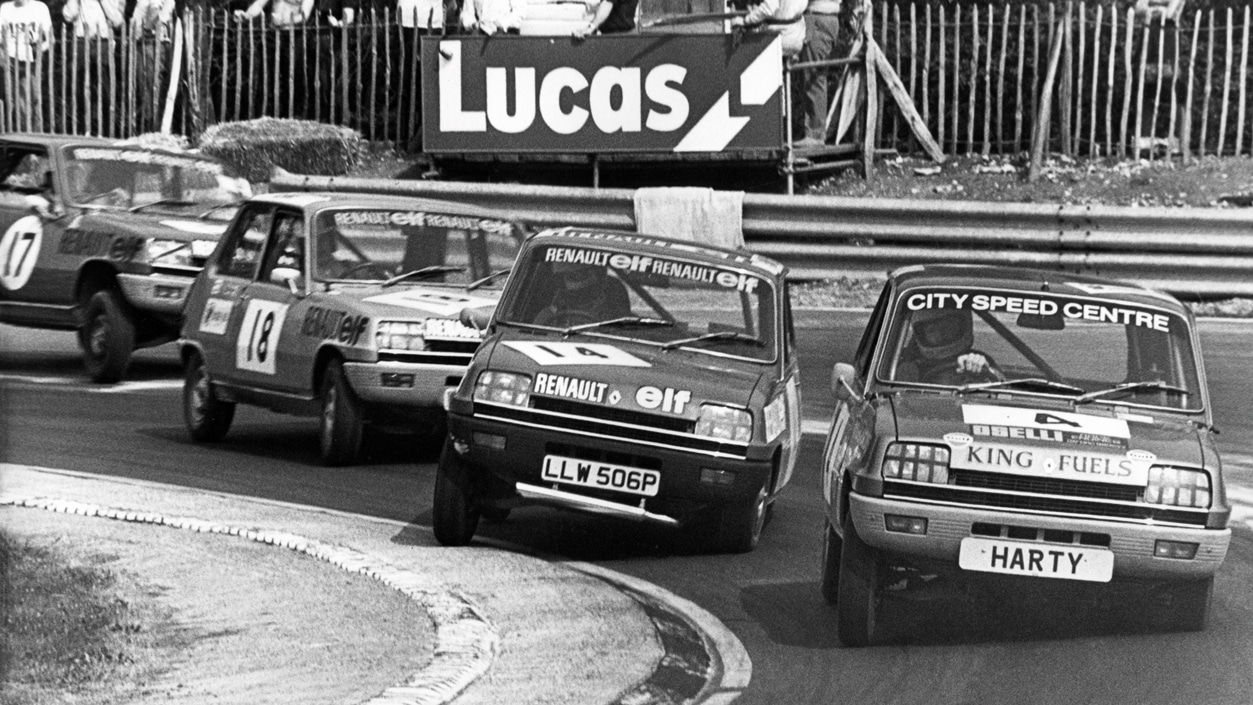
Squealing French superminis in the 1976 UK Renault 5 Cup
Jeff Bloxham

The TVR Tuscan Challenge, around since 1989, was an inspiration for Rover in the 1990s
Jakob Ebrey
For more than a decade from the mid-1980s, aspiring professional racing drivers and club racers alike never had it so good. As car companies attempted to spice-up their image and reach new customers, one marketing tactic was to turn to motor racing. It fuelled a boom in one-make championships, where generous prize funds ensured packed grids and spectacular crash-bang-wallop racing.
Drivers climbed onto the one-make ladder, viewing it as a potential step up to the British Touring Car Championship or GT racing. But they weren’t the only ones who enjoyed this period. The reputations of fresh-faced racing teams were established, club races drew healthy spectator numbers for circuits, television channels satisfied millions of motor racing fans, promoters learned their trade and sponsors wheeled and dealed with their network from the vantage point of hospitality suites at tracks around the UK.

Caterhams
Jeff Bloxham
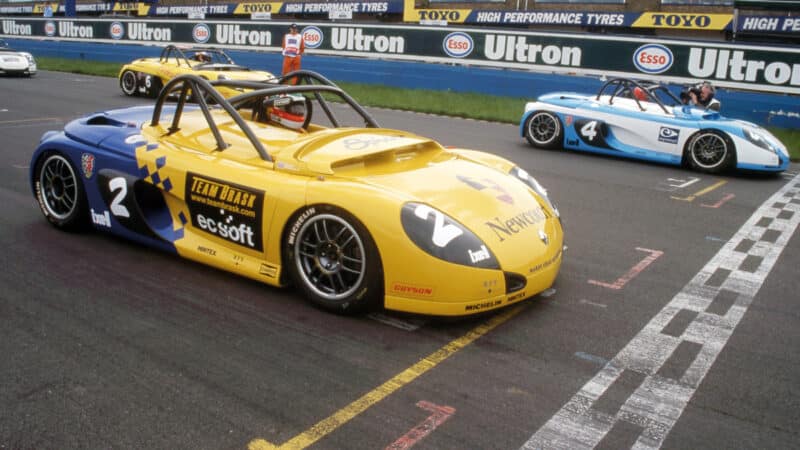
Sport Spiders
Jakob Ebrey
It was a shrewd move on the part of car makers. The cost of fielding factory teams in high-profile championships like the BTCC could run to millions of pounds unless a sponsor was secured. The cost of running a one-make championship was comparatively small change. In fact, get your sums right and the manufacturer might even make a nice little sum on the side, selling race cars and spare parts over several seasons.
“At the sharp end a do-or-die mindset meant things were far from chummy”
It brought about choice, competitive costs and plenty of prize money. Renault worked its way through the 5 Elf Turbo Cup, Clio 16V Cup, Sport Spider and then further iterations of the Clio Cup. Ford had its long-serving Fiesta series, Honda stepped into the mix with the CRX. While this was all going on, MG was running the Metro championship, initially as the standard MG Metro before upgrading to the Turbo version, then it was Rover’s turn to make an impression, first with the 216 GTi then the 220 Turbo, which later made way for the MGF. On the fringes was Mazda with the MX-5, and Volkswagen with its Polo G40 and Vento VR6. All this before you even consider Caterham and TVR.
From the outside, these one-make series appeared competitive and good-natured. But at the sharp end a do-or-die mindset meant things were far from chummy…
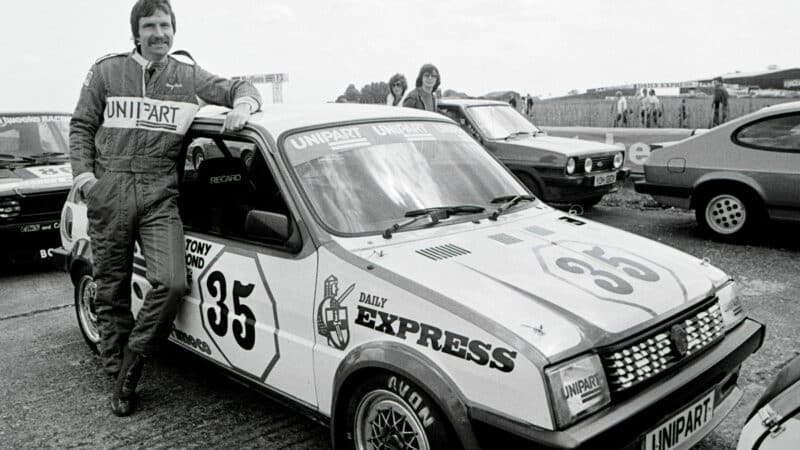
Tony Pond was pivotal in the formation of Metro racing
Jeff Bloxham
Keeping costs capped
Long before Formula 1 introduced its £115m cost cap for each team, in 2021, organisers of one-make championships were perfecting ways to keep racing affordable. For example, in the Renault 5 Turbo Cup, introduced in 1985, Renault would sell a new 115bhp production-based car for less than £11,000, but it then needed to be fitted with safety equipment and a spares package.
In the Honda CRX Challenge, which from 1988 brought similarly packed grids as the Renaults – Honda allowed 35 competitors to register for a season – the cost of the 130bhp car was £9650, a price that even included all the parts needed to prepare them for racing.

Renault 5 Turbo racing, 1982
Jeff Bloxham
By contrast, the more powerful 200bhp Rover 220 Turbo was £13,400 and the approved race kit added a further £5600, which is still precious little to race in a series that was effectively one step beneath the BTCC and supported the British Grand Prix.
Gavin Green was deputy editor of Car magazine at the time, and found himself with the chance to race in the Renault 5 Turbo Cup, which turned into a three-season stint. “It was competitive because the cars were pretty well identical. The racing was incredibly close and it was very exciting. Renault put a lot of effort into it and we raced at all the premier circuits, including at the British Grand Prix.”

Martin Short raced Rovers in the early ’90s
Jakob Ebrey

Rivalries in 5s, 1981
Jeff Bloxham
Happily for Green, who had been approached by Tim Jackson, Renault’s PR and motor sport lead, he landed with Radbourne Racing, which was effectively regarded as the ‘works’ team. What was Renault trying to achieve from running such a series, and inviting journalists and a few high-profile celebrity drivers? “It was an important hot hatch to them [Renault],” says Green, “and I think they were regarded as a cheap and cheerful French car maker but they were trying to ramp up the sporty desirable image, on the coat-tails of the hot hatch magic.”
To further prevent those with the biggest budgets winning all the races, the regulations stipulated what could and couldn’t be changed. Steve Carter, who was project engineer for the 220 Turbo at the time, and was one of the team that developed the racing variant, says in its case Rover had learnt how to maintain a level playing field through the earlier Metro and 216 GTi championships.
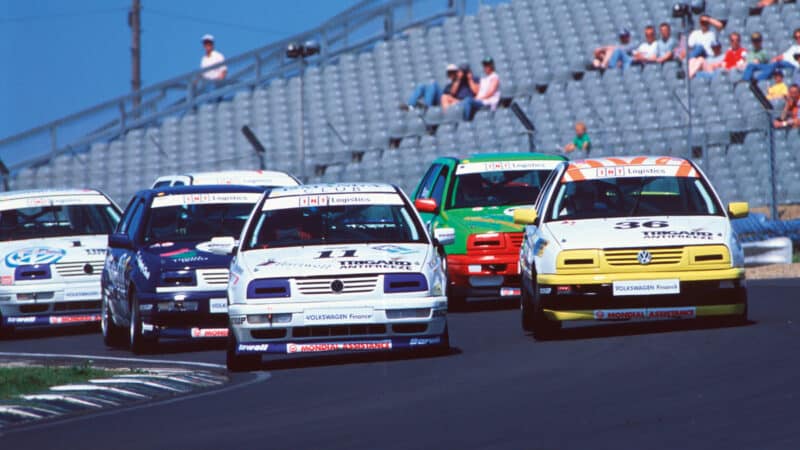
Tempting 1990s packed house at Brands to go out and buy a VW Vento…
Jeff Bloxham
“With the turbo it brings more opportunities for bending the rules,” recalls Carter with more than a hint of diplomatic overtones, “so as with the 216 we went for a sealed engine, sealed gearbox, a minimal number of changes and a more developed tyre. With the Torsen diff in it, it handled quite well, and we did enough with the suspension to keep the geometry stable.”
Carter recalls that the team behind the project was inspired by the TVR Tuscan series, which served up close racing. To that end, they called on the services of Tony Pond, an Austin Rover stalwart who gave the Metro 6R4 its best result in rallying. It was his job to fine-tune the concept so it could be enjoyed by both amateurs and aspiring professional racing drivers alike. “We didn’t want a car that was docile,” says Carter.
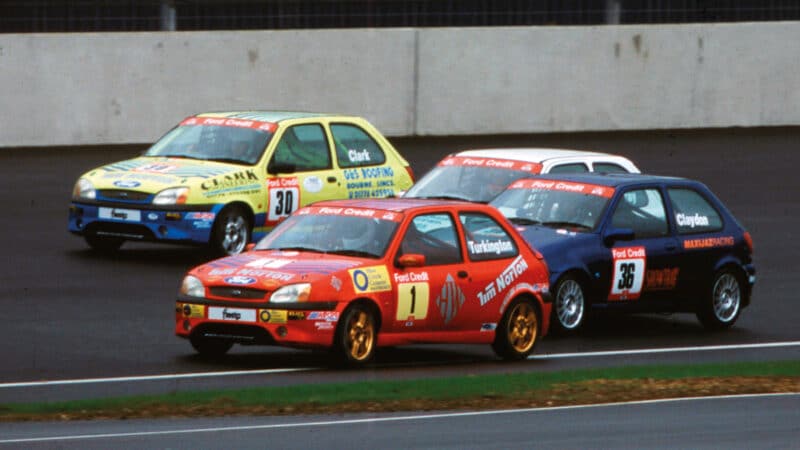
BTCC hero Colin Turkington (1) made his name racing Ford Fiestas
Jeff Bloxham
He reckons sponsors were impressed by what they found. Here was a series that was visibly professional in its approach, offered networking opportunities at the British Grand Prix, a race at Spa, extensive television coverage on ITV and satellite channels with audience numbers to rival the BTCC, and the power of Rover’s marketing and PR departments. It was a compelling package.
“I had a bit of trouble picking up Radio 4 but apart from that all good”
This in turn brought experienced drivers, many of whom had plenty of championships under the belt. But in the Renault 5s, one of Green’s favourites came in the unlikely form of perennial backmarker, Lawrence Edscer. He once asked Green how he’d got on during a race at Paul Ricard, and Green asked the same question back. The response was one of the funniest quips he’d heard in racing: “Well, I had a bit of trouble picking up Radio 4 but apart from that all good!”
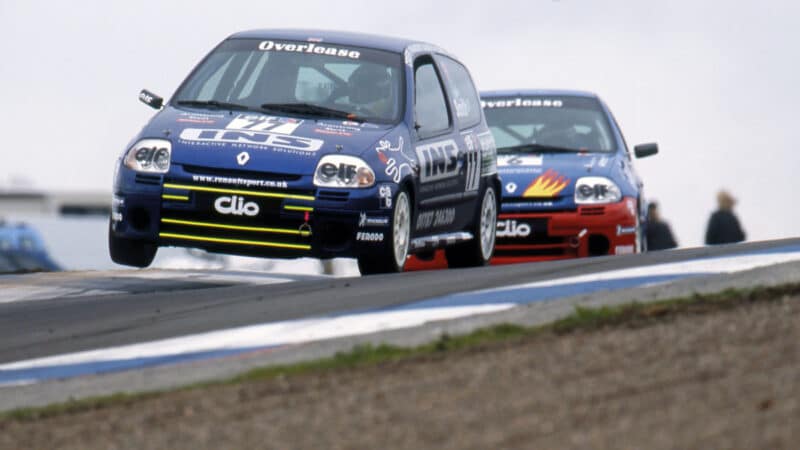
Clio cups have been a worldwide hit for more than 30 years
Jakob Ebrey
Mind games
At the front of the pack, one-make racers possessed the sharpest of sharp elbows. “If you went into a new or existing one-make championship and you were quick, it was serious stuff,” recalls James Kaye, who raced in the 5 Turbos, Fiestas, MX-5s and CRXs, often all in the same season, as he beat a path to BTCC. “You didn’t get any of this patting on your back stuff. And that went on all the way through my career.
“I only have a small number of people in motor sport, even though I have been in it since God was a boy, that I have long-lasting friendships with. Most of them I wouldn’t piss on if they were on fire. So what it [one-make racing] did for me was it provided me with an incredible background for racing.”

The Dunlop Rover Turbo Cup offered close racing in the mid-1990s; big sponsors were impressed
Jakob Ebrey
In the holding area before a race, old hands would sidle over and say to Kaye: we’re by far the fastest, so let’s put on a bit of a show for the crowd; I’ll lead into the first corner, we’ll run a few laps at a procession, then battle it out for the flag. “When you’re young and naive, you think, ‘That’s a good idea, because we are so much quicker,’ and then it gets to the first corner and he’s away!”
“I had notes put under my hotel door – threatening undertones”
Kaye says the rivalry and chicanery in one-make racing was as intense as anything else he’s experienced. “I had notes put underneath my hotel door, saying things like, ‘I know you’ve got two kids.’ There were threatening undertones.”

Renault was a major supporter of motor sport through its Clio Cup
Jakob Ebrey
Martin Short is similarly dismissive of the view that one-make racing was only for the crack. He remembers a conversation with Ben Samuelson, former PR and marketing man at TVR, during a Tuscan race weekend, after some aggro on track. “Ben came up to me and said, ‘You know, Martin, we are doing this for fun,’ and I turned to him and said, ‘Fun? Fun? I don’t do this for fun. This is life and death!’ And it was, because all of the competition was so important to me. I was obsessive about it.”
Short raced in the Dunlop Rover 216GTi and Dunlop Rover Turbo championships, and reveals the former was by far the sweeter car to drive. He also says he felt the establishment was against him when he stepped up to the Turbos. Undeterred, Short worked hard on mastering his mindset, using visualising techniques that he learned from the book The Inner Game of Tennis. “I became almost a win-at-all-costs person and made a reputation for being very tough and probably not a lot of fun.” It ultimately led him to victory in the British GT Championship and on to racing at Le Mans.

The MGF Cup started in ’98
Jeff Bloxham

Four-time BTCC champion Ashley Sutton won the Clio Cup in 2015
Jakob Ebrey
Another driver who used the platform of one-make racing to further his racing career is Patrick Watts. “Austin Rover Group was no longer employing and Richard Asquith, who was just up the road from me, said, ‘Why don’t you do the Honda CRX series?’”
Impressed by the support Honda had in place, he ran with G&M Motors as the dealer entrant and had Asquith prepare the car. “I was overawed by the competition. My car wasn’t ready so the first time I stepped into it was qualifying for the first round of the championship. I qualified sixth and thought, ‘If I can maintain sixth among this lot I’ll be happy. So I was very relaxed. I won the race. And then you go into the second race and you’re not relaxed; you can only go backwards from winning. You were not the hound chasing the fox, you were the fox. You would only have a bad day if you didn’t win, get pole and fastest lap. That’s where the money was.”
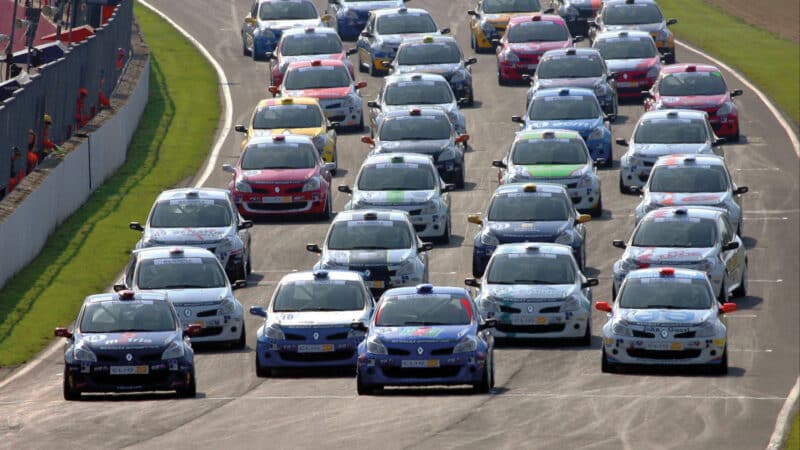
A capacity Brands Hatch grid for the 2007 Clio Cup season opener
Jakob Ebrey
By contrast to the 16-valve four-pot CRX, the turbocharged 5 was all about torque, says Kaye. “You changed gear a lot earlier than you thought, and had to lower the rear a lot which was counter to what we’d been doing for a front-wheel drive car. It changed the angle of the front wishbones and allowed it to get more grip at the front.” Kaye says the 5 Turbo was quicker than the Fiesta, “but the Fiestas were probably the best racing.”
Paid drives, paying customers
The prize money put up by the manufacturer was meaningful. For example, in 1994 Rover Sport paid £370 for first place, £330 for second and £290 for third, while there were ‘bonus awards’ for simply turning up and taking part, of between £180 and £230 per race, or £400 for an overseas event.
That wasn’t the only way drivers would make money, though. The fastest people on the grid would be lured with paid drives by teams, for the simple reason that having a winning driver running under your banner attracted paying drivers into the fold. “It was extremely serious; it was my livelihood,” says Kaye. He remembers he’d be paid £250 a race plus expenses, a percentage of the prize money, plus a new car at the end of the year if he won the championship. Winning those races and taking a championship “opened up so many doors” to the BTCC, says Kaye.
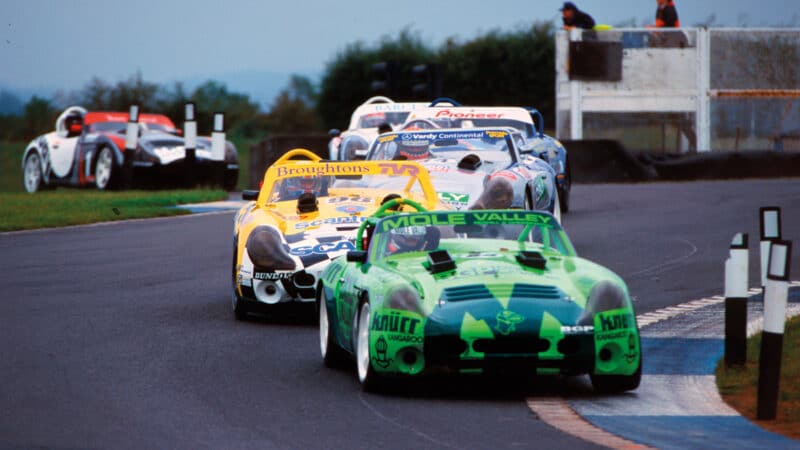
TVRs at Donington, 1997
Jeff Bloxham
The level of manufacturer support, affordable costs, ultra-competitive driver fields and healthy prize money created an accessible launchpad for those hoping to further their driving career, and gave amateurs a blast further down the grid.
Perhaps Kaye sums it up best. “With the way that motor racing has gone in the UK over time, it will need something very special to get back to that situation.”
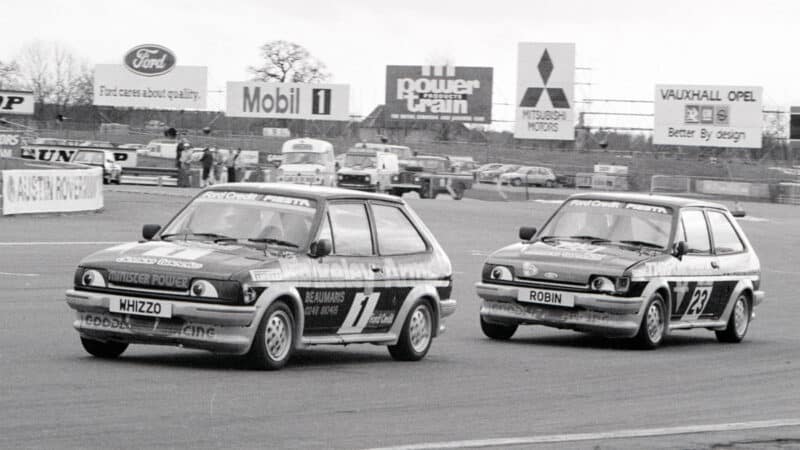
‘Whizzo’ and ‘Robin’ eye up a podium place in second-generation Fiestas
Jeff Bloxham
